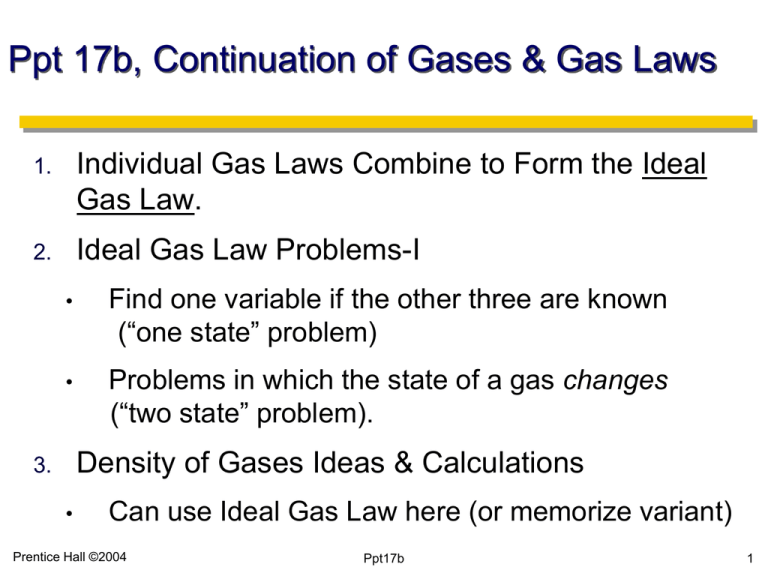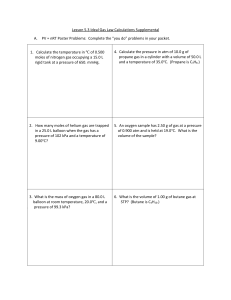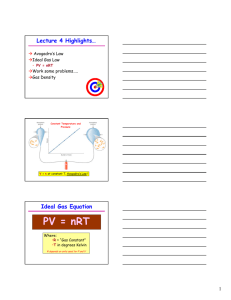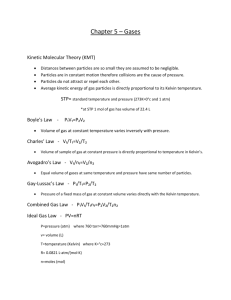Gases: Their Properties & Behavior
advertisement

Ppt 17b, Continuation of Gases & Gas Laws 1. Individual Gas Laws Combine to Form the Ideal Gas Law. 2. Ideal Gas Law Problems-I • Find one variable if the other three are known (“one state” problem) • Problems in which the state of a gas changes (“two state” problem). Density of Gases Ideas & Calculations 3. • Can use Ideal Gas Law here (or memorize variant) Prentice Hall ©2004 Ppt17b 1 Important Comment • In all previous laws, the proportionality constant, k1 , is not a fundamental constant of nature; it would depend on the conditions [the values of the other variables being held constant] Prentice Hall ©2004 Ppt17b 2 The Ideal Gas Law 01 • Ideal gases obey an equation incorporating the laws of Charles, Boyle, and Avogadro: PV PV nRT R (a fundamental constant) nT [same for all gases, conditions] • The gas constant R = 0.08206 L·atm·K–1·mol–1 • STP conditions are 273.15 K and 1 atm pressure • 1 mole of an ideal gas occupies 22.41 L at STP (molar volume = V of 1 mol) nRT (1 mol)(0.08206)(273.15 K) 1 mol V 22.414..L at STP P 1 atm Prentice Hall ©2004 Ppt17b 3 The Ideal Gas Law • 02 Sulfur hexafluoride (SF6) is a colorless, odorless, very unreactive gas. Calculate the pressure (in atm) exerted by 1.82 moles of the gas in a steel vessel of volume 5.43 L at 69.5°C. • What is the volume (in liters) occupied by 7.40 g of CO2 at STP? Prentice Hall ©2004 Ppt17b 4 What if more than one variable changes? • Oxygen gas is normally sold in 49.0 L steel containers at a pressure of 150.0 atm. What volume would the gas occupy if the pressure was reduced to 1.02 atm and the temperature raised from 20oC to 35oC? PV PV 1 1 R 2 2 n1T1 n2T2 PV PV 1 1 2 2 T1 T2 (n constant) P1 T2 V2 V1 x x P2 T1 Prentice Hall ©2004 Ppt17b 5 Example #2 • An inflated balloon with a volume of 0.55 L at sea level, where the pressure is 1.0 atm, is allowed to rise to a height of 6.5 km, where the pressure is about 0.40 atm. 1) Assuming that the temperature remains constant, what is the final volume of the balloon? 2) Assuming that the temperature at sea level is 22°C and the temperature at 6.5 km is -28°C, what is the final volume of the balloon? Prentice Hall ©2004 Ppt17b 6 Gases Worksheet-I Practice • Proportional relationships / calculations Prentice Hall ©2004 Ppt17b 7 The Ideal Gas Law--Applications • 04 Recall: At the same T and P, equal volumes of gases contain equal numbers of molecules. • V n (P, T constant) Implication? The concentration of gas particles is “fixed” at a given T and P! n P PV nRT a fixed value V RT (at a given P & T, for any gas!) Prentice Hall ©2004 Ppt17b 8 At the same T & P, [gas] is “fixed” (sample size does not matter) (identity of the gas does not matter) Same T & P … He H2 Ar Prentice Hall ©2004 He …same number of particles per L Ppt17b 9 Density of a gas at fixed T and P does depend on gas identity (molar mass)! Density is “number density” x mass per particle • Which equals concentration x molar mass! • g mol g x L L mol m n d x MM V V • This slide is intended to make a conceptual connection, not give you another equation to memorize! One could substitute in for n/V here to get an equation that relates d, P, T, and MM, – but I don’t think it’s really “worth it” (see answer key comments) Prentice Hall ©2004 10 Summary (of prior few slides): At the same T & P, concentration is constant, but density varies with MM Same # particles / L, but… He H2 Ar Greatest density b/c greatest MM Prentice Hall ©2004 He …different densities for different gaseous substances, because mass per particle (and thus per mole) varies! 11 Practical Application: Will gases (or balloons filled with them) float or sink (in air)? MM is the key! • Air is about 80% N2 and 20% O2 MM(air) 29 g/mol Substance or Mixture Molar Mass (g/mol) Floats or sinks in air? (at same T, P) H2 2.0 floats He 4.0 floats Air ~29 Neither (but balloon would sink b/c the rubber makes dballoon slightly > dair) CO2 44 sinks Quiz: Would a neon balloon float or sink? Argon? Prentice Hall ©2004 Ppt17b 12 The bottom line? Density of a gas depends on molar mass, T, & P, but not on “amount” • Since amount does not matter, I prefer to PICK A CONVENIENT AMOUNT* to solve problems that relate to gas density and molar mass! No need to memorize or derive separate equations (although if you want to do so, more power to you!) * 1 L of gas, if density is given; 1 mol of gas, if molar mass (or formula) is given Prentice Hall ©2004 Ppt17b 13 The Ideal Gas Law—Applications (Examples) • What is the molar mass of a gas with a density of 4.07 g/L at a pressure of 3.42 atm and 35°C? • What is the density of uranium hexafluoride, UF6, (MM = 352 g/mol) under conditions of STP? • To what temperature must a sample of CO2 be raised at 1.97 atm in order for the density to become 3.38 g/L? Prentice Hall ©2004 Ppt17b 14








